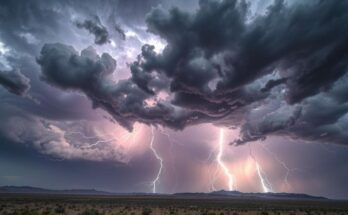On March 21, the weather in Uzbekistan will vary significantly. Tashkent is expected to be partly cloudy with temperatures ranging from 12-29 degrees Celsius. Other regions may experience rain, while mountainous areas face avalanche risks. Wind speeds will vary across regions and temperatures will range from 2-30 degrees Celsius depending on the location.
On March 21, “Uzhydromet” forecasts varied weather across Uzbekistan for Navruz. In Tashkent, the forecast indicates partly cloudy skies with no expected precipitation. Winds from the east will average between 3-8 meters/second but could increase to 10-12 meters/second. Daytime temperatures are anticipated to range from 27-29 degrees Celsius while nighttime temperatures will be between 12-14 degrees Celsius.
In the Republic of Karakalpakstan and the Khorezm region, the weather will similarly be partly cloudy, but some areas may experience rain. Winds are forecasted from the west at 7-12 meters/second, potentially increasing to 15-20 meters/second. Temperatures are expected to reach 9-14 degrees Celsius at night and 15-20 degrees Celsius during the day.
The Bukhara and Navoi regions will experience slightly cloudy weather with little precipitation forecasted, although Navoi may see some rain. Winds will shift to the west at 7-12 meters/second and could gust up to 13-18 meters/second. The temperatures will be 9-14 degrees Celsius during the night and rise to between 25-30 degrees Celsius by day.
In Tashkent, Syrdarya, Samarkand, and Jizzakh regions, expect slightly cloudy conditions without precipitation. Winds from the east will be around 7-12 meters/second, increasing to 13-18 meters/second in some areas. Nighttime temperatures will hover between 9-14 degrees Celsius, while daytime temperatures will be 24-29 degrees Celsius.
Kashkadarya and Surkhandarya regions will also be slightly cloudy with no expected precipitation. Winds will blow from the east at 7-12 meters/second, with a potential increase to 13-18 meters/second. Nighttime temperatures will average 10-15 degrees Celsius, while daytime temperatures will rise to between 25-30 degrees Celsius.
In Andijan, Namangan, and Fergana regions, partly cloudy weather is anticipated with no precipitation expected. Winds from the east are projected at a speed of 5-10 meters/second. Night temperatures are expected to be 7-12 degrees Celsius, with daytime highs ranging from 22-27 degrees Celsius.
Mountainous regions of the republic will be partly cloudy with variable conditions, though precipitation is not expected. However, there is a risk of avalanches due to anticipated weather conditions. Winds will be from the east at 7-12 meters/second, with potential gusts up to 13-18 meters/second. Temperatures will drop to between 2-7 degrees Celsius at night and rise to 12-17 degrees Celsius during the day.
Due to the forecast for precipitation and temperature fluctuations from March 21-25, a risk of avalanches has been declared in regions including Kashkadarya, Surkhandarya, Samarkand, Jizzakh, Tashkent, and Namangan.
The weather forecast for Uzbekistan on the day of Navruz, March 21, indicates a diverse range of conditions across different regions. While Tashkent will enjoy pleasant, partly cloudy weather, some areas like Karakalpakstan and Khorezm may see rain, and temperatures will vary significantly across regions. Importantly, conditions may lead to a heightened risk of avalanches in several areas, necessitating caution.
Original Source: zamin.uz




